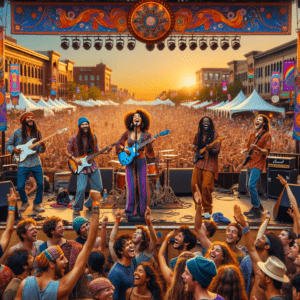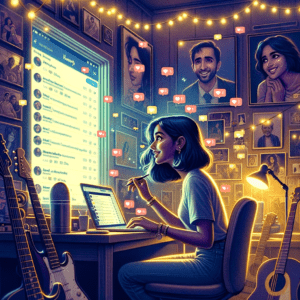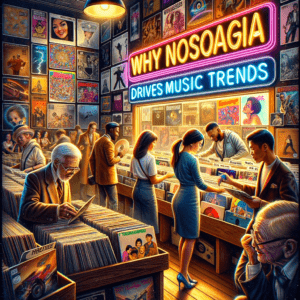Hip-hop, Baby! It’s a Global Groove
Oh man, lemme tell you about hip-hop. It’s like falling head over heels into a love affair that nobody saw coming. It’s wild, it’s unpredictable, and yet, here we are, decades later, and it’s still sizzling with passion everywhere you look. I can still remember the first time I tripped over my sneakers to the beat dropping—it was like magic washing over me slowly. Seriously, who would’ve thought? This art born from the streets, rooted in gritty, real struggles, transformed into this worldwide phenomenon. Against every odd, it found its voice and gave power to those who felt voiceless, spinning tracks that had us all locked into the same rhythm.
Looking back, hip-hop was as American as apple pie but with way more attitude—like a rebel cousin to it. When it emerged from the Bronx in the ’70s, full of breakbeats and graffiti art, it was like watching some Shakespearean drama unfold where DJs, MCs, b-boys, and spray can wizards were the stars. Fast forward, and these MCs, with their swagger and grit, stood toe to toe with the big wigs of the music industry. Who saw that coming?
But hold up, let’s rewind. The late ’70s and early ’80s were like the baby years for hip-hop. Kids in the Bronx were scratching on turntables, nicking beats from funk and disco to create something fresh. It was raw and real—impossible to ignore. Like catching a fever that you didn’t actually want to shake off.
And those stories! Man, they were so raw, so unfiltered. Rappers spilling their truths, taking us on the journey through their lives, filled with hardships but also this almost rebellious joy that screamed, “We’re here, listen up!” You could feel it, like this electric pulse—simply mesmerizing.
Then, bam! Hip-hop shot off beyond US borders, cruising across oceans faster than the latest TikTok firestorm. It spread like a wildfire, tweaking and reshaping with every culture it embraced. And that’s the thing about hip-hop—it plays the perfect chameleon. Changing, evolving, fitting in snugly no matter where it lands.
Take France, for example. Those stylish streets absorbed it, and they turned it into their own groove. Artists like MC Solaar mixed that American grit with French sophistication, spinning it into something beautiful. And Japan? Wow, they got innovative, fusing traditional sounds with those breakneck beats—these lyrical flows were like nothing else out there. It’s this magnificent mix of history and now, and it’s not just watching from the sidelines—it’s participating.
And oh, Africa! The motherland! Hip-hop found a soul there, another home. It struck a chord with Africa’s storytelling heart. Artists from Nigeria to South Africa picked up the mic to tackle political issues, societal norms, and celebrate their roots with a passion that fueled the genre’s beat.
Yet, as it journeyed, hip-hop didn’t always get a warm welcome. Some places found it hard to cozy up to, viewing it as a rebel, a threat to their comfy norms. But you see, hip-hop’s not just music—it’s culture, lifestyle, life itself speaking to resilience. Slowly, it grew on folks, delivering unmistakable messages of strength and hope, clearing barriers, forming a universal language for dreamers, the outcasts, and the young with fire in their bellies.
Fast forward to today, hip-hop’s everywhere. It’s in our tunes, our fashion, even our colloquialisms. Almost like a beat under our skin, creeping into everyday life. There’s just something about screaming out to a rap song, feeling that bass drop like revving up on sheer adrenaline. A nudge to our shared humanity, embracing the diverse voices that color our world.
Sure, hip-hop’s global presence didn’t come without hurdles—there were accusations tossed at it about promoting the not-so-nice stuff like violence, misogyny, you name it. It’s been poked, prodded, and examined more times than I can count. But the core? Untouched. It keeps connecting, igniting conversations, and urging the voiceless to speak up.
In my two cents, the magic of hip-hop on the global stage is in its rebellious heart. It’s that defiant teenager refusing to bend to proverbial norms. It’s a reminder that each of us has a voice longing to be heard. It’s a celebration, a movement testing boundaries, pulling folks together in ways other genres just dream of. It’s raw, emotional, and it wears its truth proudly—flaws and all.
So here we stand in this incredible year, 2023, toes tapping to beats that first reverberated on Bronx sidewalks. Hip-hop spun us into a trance, linking continents, cultures, and bridging even the generational chasms. It’s this utterly unpredictable joyride—a classic underdog victory, a ride over the hurdles, and this marvelous, twisty journey that music waltzes us through.
In conclusion, hip-hop’s tango with the global stage isn’t tied up in perfection or the absence of wrinkles. It’s about voices, rhythms, stories, the bold defiance to rise and be heard. Globally, hip-hop’s not going anywhere in a hurry. Who knows where it’ll wander next? But what’s certain—it won’t stop evolving, won’t pause in challenging us, and will never halt making us groove to its utterly captivating beats. I can’t help but grin, wondering what’s around the corner.













